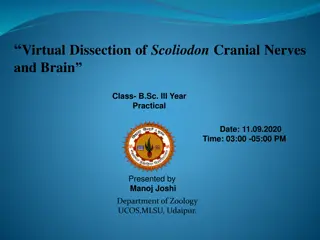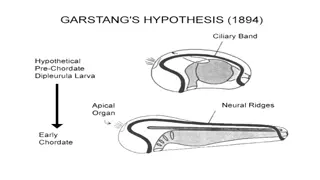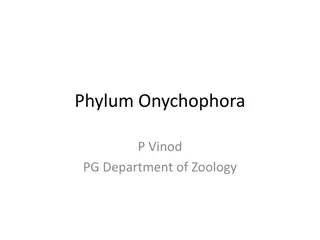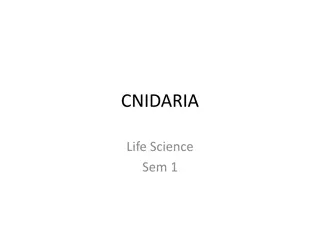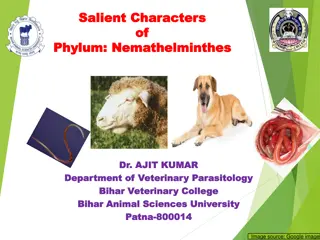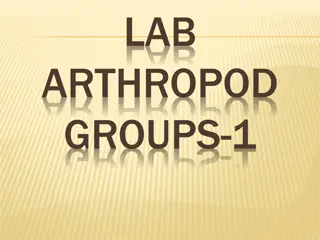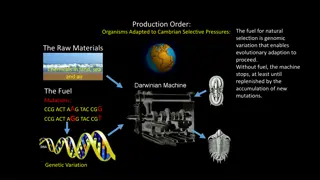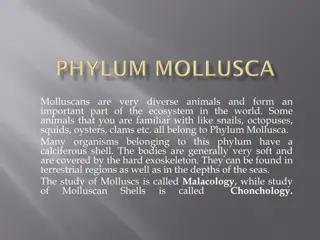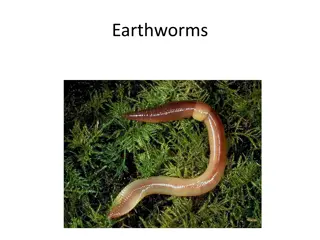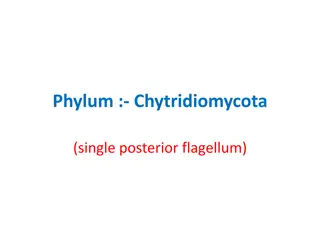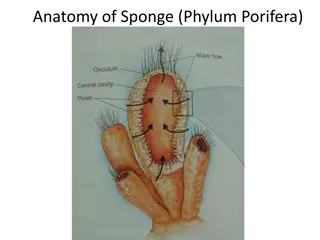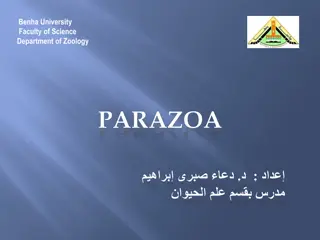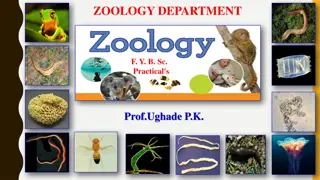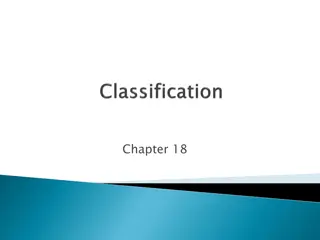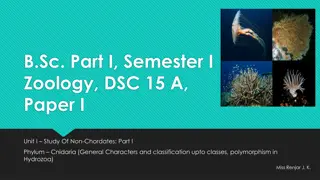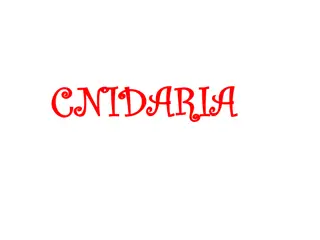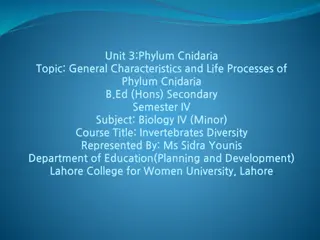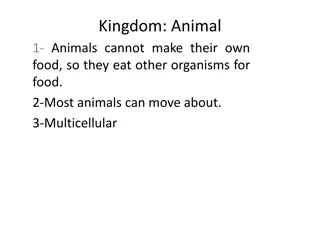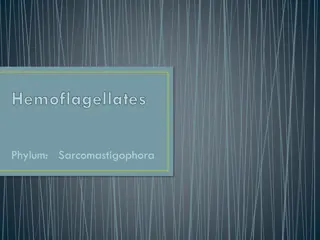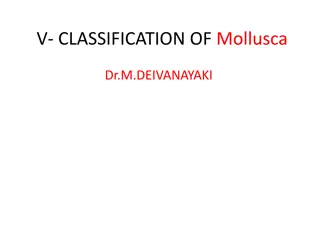
Arthropoda: Joint-Footed Animals with Bilaterally Symmetrical Body
Explore the characteristics of Arthropoda, joint-footed animals with a bilaterally symmetrical body having three tagmata - head, thorax, and abdomen. Learn about the cephalization, cuticular skeleton, appendages, circulatory system, respiratory organs, and more in this detailed overview of the phylum Arthropoda.
Download Presentation

Please find below an Image/Link to download the presentation.
The content on the website is provided AS IS for your information and personal use only. It may not be sold, licensed, or shared on other websites without obtaining consent from the author. If you encounter any issues during the download, it is possible that the publisher has removed the file from their server.
You are allowed to download the files provided on this website for personal or commercial use, subject to the condition that they are used lawfully. All files are the property of their respective owners.
The content on the website is provided AS IS for your information and personal use only. It may not be sold, licensed, or shared on other websites without obtaining consent from the author.
E N D
Presentation Transcript
PHYLUM ARTHROPODA Joint footed animals Bilaterally symmetrical body with tagmosis and cephalization Body- 3 tagmata or divisions- head, thorax and abdomen Cephalization- fusion of anterior segments Cephalothorax covered by carapace Cuticular skeleton- secreted by epidermis of the body wall- restricts the unlimited growth of the body, provides protection, prevents water loss Moulting or ecdysis Jointed and segmentally paired appendages- segments of these appendaged are called podomeres- flexors and extensors Appendages uniramous or biramous
Striped muscles Perivisceral haemocoel and reduced coelom Open circulatory system with dorsal heart blood flows through open channels and spaces and not through closed blood vessels Respiratory organs include branchiae, tracheae, book gills and book lungs Excretory organs - Malpighian tubules and green glands Annelidan type of nervous system Absence of locomotor cilia
PENAEUS INDICUS(class malacostraca) Cephalothorax (fusion of 13 segments-5 cephalic and 8 thoracic) and abdomen(6 segments) with a telson Cuticular skeleton, secreted by underlying epidermis(formed of chitin and protein)- has infolding called apodemes Segments called sclerites Abdominal region terga (dorsal sclerite) and sterna (ventral sclerite) Pleuron extension from tergum Epimeron the part between pleuron and abdominal appendage 13 tergal plates fuse to form carapace Sternal plates form ventral shield Thelycum on female Rostrum compound eyes Branchiostegite - gill cover
Appendages 19 pair- 5 cephalic , 8 thoracic and 6 abdominal Attach to sternum of exoskeleton Segmented (podomeres ) and biramous Base called protopodite- 2 segmented- coxa and basis Rami- exopodite(unsegmented) and endopodite (segmented in some) Cephalic appendages Antinnule and antennae- tactile structures Mandible masticatory structures 1stmaxillae and 2ndmaxillae- feeding jaws
Thoracic appendages 8 pairs Maxillipeds or foot jaws- first 3 Pareopods or walking legs- rest 5 All are biramous with 2 segmented protopodite 5 segmented endopodite- ischium, merus, carpus, propodus and dactylus Maxillipeds- exopodite well developed and unsegmented To the coxa of maxillipeds and chelipeds is a respiratory process called epipodite Pareopods- 1st3 are chelate legs or chelipeds(formed by propodus and dactylus) Last 2 non chelate pareopods- no epipodite
Abdominal appendages For swimming- called pleopods or swimmerets Biramous- 2 segmented protopodite, unsegmented exopodite and endopodite Last pair uropods- serve as tail fins In uropod coxa and basis fuse to form single segment sympod In male prawns- 1stpair of pleopods- endopodite has small hooks- with this right and left appendages interlock and form petasma (used for transferring sperms to the thelycum of female)
Digestive system Alimentary canal and digestive gland, called hepatopancreas or liver Alimentary canal 3 divisions- stomodaeum, mesodaeum and proctodaeum Stomodaeum (fore gut) consists of mouth, buccal cavity, oesophagus and stomach Mesodaeum (mid gut)- intestine Proctadaeum (hind gut) rectum and anus Intima internal cuticular lining of stomodaeum and proctodaeum Mouth Situated in between 3rdand 4thcephalic segments Guarded infront by chitinous plate, called labrum or upper lip, on sides- mandibles and behind by labium or lower lip Labrum is bilobed- 2 lobes called paragnathae
Buccal cavity (compressed chamber) and oesophagus Stomach Spacious chamber Divisions- cardiac (for storage and grinding of food) and pyloric stomach(for sorting and straining of food) On the floor of cardiac stomach- there are cuticular folds with setae and spicules Also has many tooth like denticles- serve as internal masticatory apparatus- called gastric mill Pyloric stomach also has cuticular folds- called lappets or valvulae It also has a filtering apparatus, formed of chitinous plates and comb like bristles Then comes intestine, leads to rectum, opens out by anus(guarded by muscular sphincter)
Digestive gland Only digestive gland is the bilobed hepatopancreas Surrounds the stomach Develop from mid gut as hepatic caeca Formed of branching tubules held together by connective tissue called tunica propria From each lobe is hetatopancreatic duct Serves the function of liver, pancreas and intestinal glands of vertebrates Secretes proteolytic, amylolytic and lipolytic enzymes Stores glycogen, fats and calcium and absorbs digested food
Feeding and digestion Omnivores planktonic organisms Chelipeds(food collection) 2ndmaxialle(push food into mouth) mandibles(food cut into pieces - mastication) maxillae and maxillipeds(masticated food is pushed to oesophagus) reach stomach through peristaltic movements of oesophagus In stomach- food mixed with digestive enzymes and get pulverized, strained and sorted In cardiac stomach- internal mastication and churning further contraction and expansion of stomach leads to crushing and grinding of food by gastric mill churning(mixing with hepatopancreatic secretions) Digestion mostly in cardiac stomach sometimes in hepatopancreas wherein they are ingested and digested by some phagocytic cells Absorption mostly in hepatopancreas- some in intestine
After gastric digestion, the pyloric filter separates the digested food and diverts it into hepatopancreas via hepatopancreatic ducts The absorptive cells of hepato pancreas absorb it Excess nutrients are stored in the hepatopancreas as glycogen and fats Undigested residue or faeces is 1stforced from stomach to intestine and finally passed to outside by peristaltic movements of gut wall
Respiratory system Include gills or branchiae principal Epipodites or mastigobranchiae and the vascular lining of branchiostegites- accessory respiratory structures Gills - vascular and feathery or plumose outgrowths from the thoracic appendages 18 gills on each side, lodged in the branchial chamber in between the branchiostegite and the thoracic wall Each gills is a crescentic structure, with a central axis or stem, called gill axis On this there are numerous thin, flat and bilaterally arranged plates, called gill lamellae, which in turn divided into gill filaments- this gill of tree like fashion- called dendrobranchs or dendrobranchiae Gill axis and gill lamellae is vascularised and covered by chitin layer
Each gill is attached to the body by a root through which blood vessels and nerves pass. Based on this 3 types of gills Podobranchs- foot gills- attach to the coxa of the thoracic appendages Arthrobranchs- joint gills- remain attached to the arthrodial membrane, seen at the junction between the thoracic wall and appendage Pleurobranchs- side gills or wall gills- remain attached to the inner wall of the branchial chamber In penaeus 1 pair of podobranchs- attached to 2ndmaxillipeds 11 pairs of arthrobranchs, attached to the 2ndand 3rd pair of maxillipeds and 1st4 pairs of walking legs 6 pairs of pleurobranchs, attached to the segments to which the 3rd pair of maxillipeds and 1st5 pairs of walking legs are connected
Mechanism of respiration Ventilation of gills- scaphognathites (exopodite of 2ndmaxillae) or balers vibrate- constant current of water over the gills , epipodites and branchiostegal plates- gaseous exchange takes place Setose hairs at the entrance of gill chambers prevent entry of foreign particles into the gill chambers
Blood vascular system Open or lacunar type Blood flows through open channels and spaces, sinuses and lacunae Consists blood, heart, arteries and sinuses and lacunae Capillaries and veins are absent Blood or haemolymph, is a light blue fluid - consists of plasma(with cu containing pigment haemocynanin) and colourless and amoeboid leucocytes. Hb and erythrocytes absent Heart triangular organ- in cephalo thoracic region- in the pericardial cavity below dorsal shield. Has 5 pairs of valvular lateral openings, called ostia From heart arise many arteries, its branches open to blood channels and blood spaces, which collectively constitute the haemocoel
Heart arteries blood sinuses lacunae ventral sinuses afferent branchial channels gills efferent branchial channels pericardial sinus again to heart so on
Excretory system Include a pair of antennary glands(coxal glands, green glands, or renal glands) 4 parts- end sac, labyrinth, glandular tube and bladder End sac- closed mesodermal sac with a coelomic cavity. Lined by excretory cells Connects with labyrinth through a small opening Labyrinth or glandular plexus- made of coiled renal tubules Glandular tube coiled excretory tube that leads from labyrinth and opens to bladder Bladder chamber- lined by excretory cells- renal duct opens to outside by an renal pore
Green gland function Excretion and osmoregulation Excretion and elimination of nitrogenous wastes and the excess of water and mineral ions and also in the regulation of the ionic composition and volume of blood Ammonia + urea + uric acid in prawn Elimination occurs by diffusion across gills+ From blood by ultrafiltration- reach end sac = called primary urine or ultrafiltrate undergoes reabsorption in labrynth the fluid left out in labrynth is called final urine, which contains water, ammonium compounds, uric acid, urea etc Urine collected in bladder and pass out through renal opening
Nervous system Composed of Circum oesophageal nerve ring , fused and ganglionated double ventral nerve cord and a large number of nerves Circum oesphageal nerve ring consists of Supra oesophageal ganglionic mass Above oesophagus Unspecialized brain formed by fusion of several ganglia From it arise, a pair of antennular nerves to antennules, statocysts etc, a pair of antennary nerves to antennae and a pair of optic nerves to compound eyes
Sub oesophageal ganglionic mass Below oesophagus Formed by fusion of a few ganglia From it arise, 5 pairs of nerves to mandibles, 1st maxillae, 2nd maxillae, 1st maxillipeds and 2nd maxillipeds Circum oesophageal connectives Around oesophagus Transverse nerve called oesophageal commissure, commisural nerve or visceral loop Just below oesophagus
Double ventral nerve cord Fused Has 6 thoracic ganglia and 6 abdominal ganglia From each ganglion 3 pairs of nerves 2 pairs to muscles and 1 pair to appendages Between 11th and 12th body segments, 2 nerve cords remain separate, leaving a passage for sternal artery
Sense organs 1. Statocysts For orientation and equilibrium A pair of them in the pre coxal segment of antennules Consists of a chitinous sac, attached to pre coxa through a short stalk. Chitinous sac encloses a central mass of sand grains (act as statoliths), surrounded by ring of sensory setae A sensory setae has 2 parts a swollen base (attached to statocyst wall through an arthrodial membrane) and a filamentar shaft (has many sensory bristles). Any change in the swimming position of the animal, or any movement in the surrounding water, will cause the displacement of sand grains. They press against and stimulate sensory setae. From setae impulses are transmitted to brain. Brain responds and enables the animal to properly orient itself
2. Compound eyes A pair of stalked and movable compound eyes Seen at the base of rostrum Cannot see distant objects as it has no perfect focusing mechanism or power of accomodation Formed of a large number of (2000 2500)light perceiving visual units or simple eyes called ommatidia Ommatidium Are long, rod shaped and closely packed structures Has its own focusing system, light transmitting system, photoreceptor cells and a field of vision (overlap in case of adjacent ommatidia) Adjacent ones are separated by a layer of black pigment Specialized for refracting light rays and also for eliciting sensory impulses It has a transparent cuticular covering, which serves as a cornea or as biconvex lens
The cuticular cornea is rigid in shape- so it has a fixed focal length and is incapable of accomodation in relation to the changing distance of the objects Just below cornea- a pair of epidermal cells, known as reticular cells or corneagen cells, which secretes the cuticular cornea Inner to this is a group of 4 elongated and inwardly tapering crystalline cells, called cone cells or vitrellae These cells secrete and surround a central transparent and refractive body called cyrstalline cone The vitrellae, inturn maybe surrounded by a pigmented sheath (that separates adjacent ommatidia), known as iris sheath or distal pigment sheath formed of pigment cells- called chromatophores.
Beneath vitrellae is a group of 7 or 8 elongated cells, called retinular cells or retinulae they contain light sensitive visual pigment rhodopsin Rhodopsin when sensitized by light undergoes chemical change which elicits an action potential transmitted to brain as a nerve impulse Retinular cells surround a central refractile rod rhabdome, formed by interdigitation of microvilli of retinular cells Retinular cells are surrounded by a pigmented sheath, called retinular sheath or proximal pigment sheath From each retinular cell is an axon at its terminal portion 7-8 axons from each ommatidium join optic ganglion Axons from all ommatidia together form an optic nerve which joins the brain
Dioptric apparatus or focusing apparatus the portions of ommatidium that comprises the cuticular lens, lenticular layer and vitrellae Remaining part i.e, rhabdome, retinular cells and the reticular sheath forms receptor apparatus or receptor region Each ommatidum rests on a basal membrane or basal lamina
Working of compound eye 2 mechanisms Mosaic vision In bright light Pigment cells fully expand and spread all over the ommatidium isolating adjacent ommatidia from each other- thus each becomes an individual visual unit They will be stimulated only by the parallel or perpendicular rays falling on the cornea- thus each can form an image of only a portion of the object All the images obtained are integrated in the brain Complete image is formed by the apposition of fusion of of several partial images called apposition image or mosaic image Such a vision called mosaic vision or apposition vision
Superimposed vision In dim light or night Pigment cells contract very much so adjacent ommatidia overlap each other forming a visual complex Images formed by adjacent ommatidia overlap and vision becomes blurred called superimposition image or super imposed image Object cannot be seen clearly but can detect moving objects
Reproduction Sexes are separate Also some degree of sexual dimorphism Male has petasma and female has thelycum Male genital openings are seen on the coxal segment of the last pair of walking legs, but female openings are seen on coxa of the 3rd pair of walking legs Male organs Include a pair of testes one on each side of thorax Testes - formed of numerous long and coiled seminiferous tubules 2 Testes are connected anteriorly, while separate posteriorly Has testicular diverticula A vas deferens or sperm duct- which leads to a seminal vesicle or ejaculatory bulb- then comes ejaculatory duct that opens out to coxa of last walking leg
Secretions of seminal vesicle glue sperms together and form sperm clusters- spermatophores- stored in seminal vesicle Female organs A pair of ovaries, one on each side of thoracic and abdominal regions United posteriorly while separate anteriorly Ovarian diverticula Oviduct- opens to coxa of 3rd walking leg

